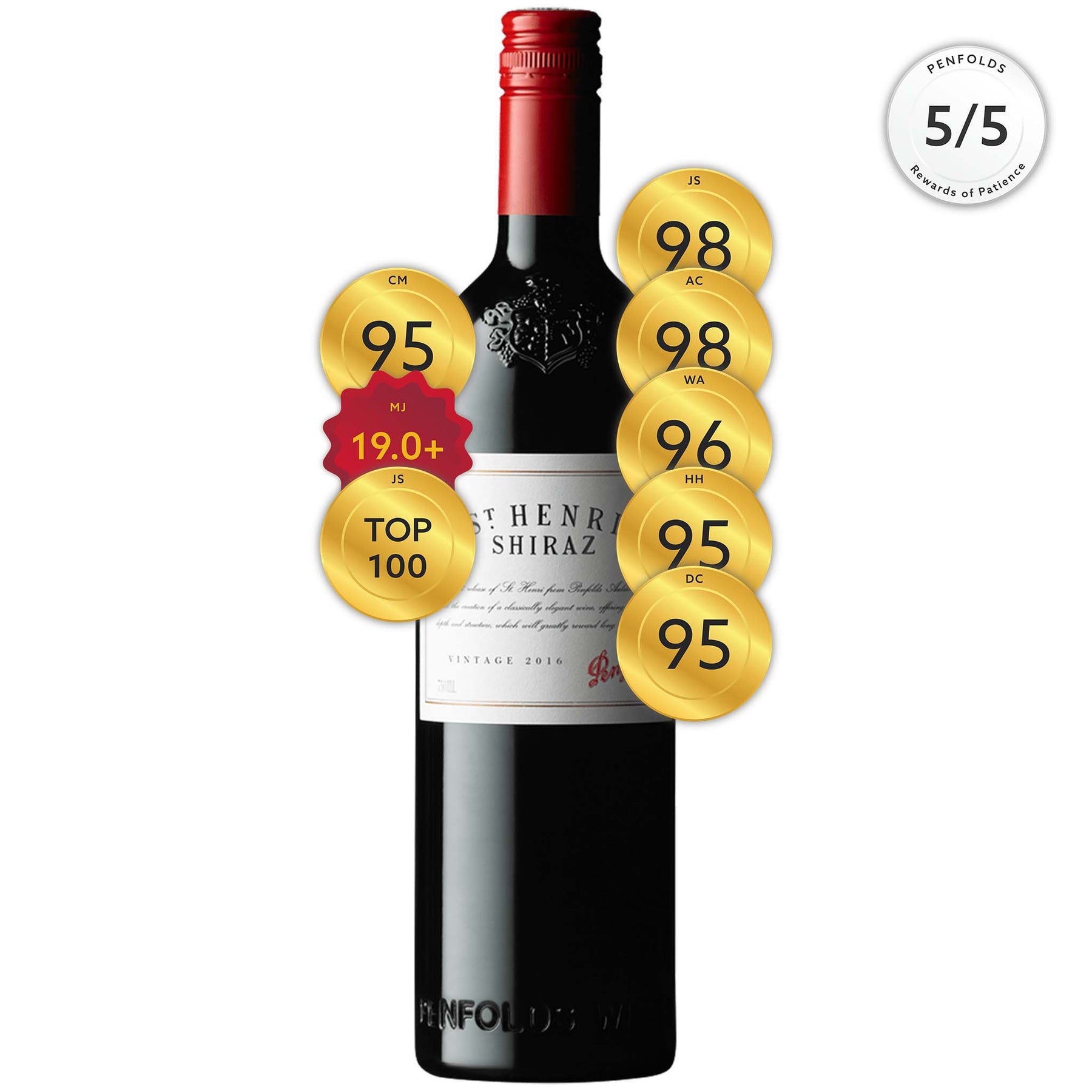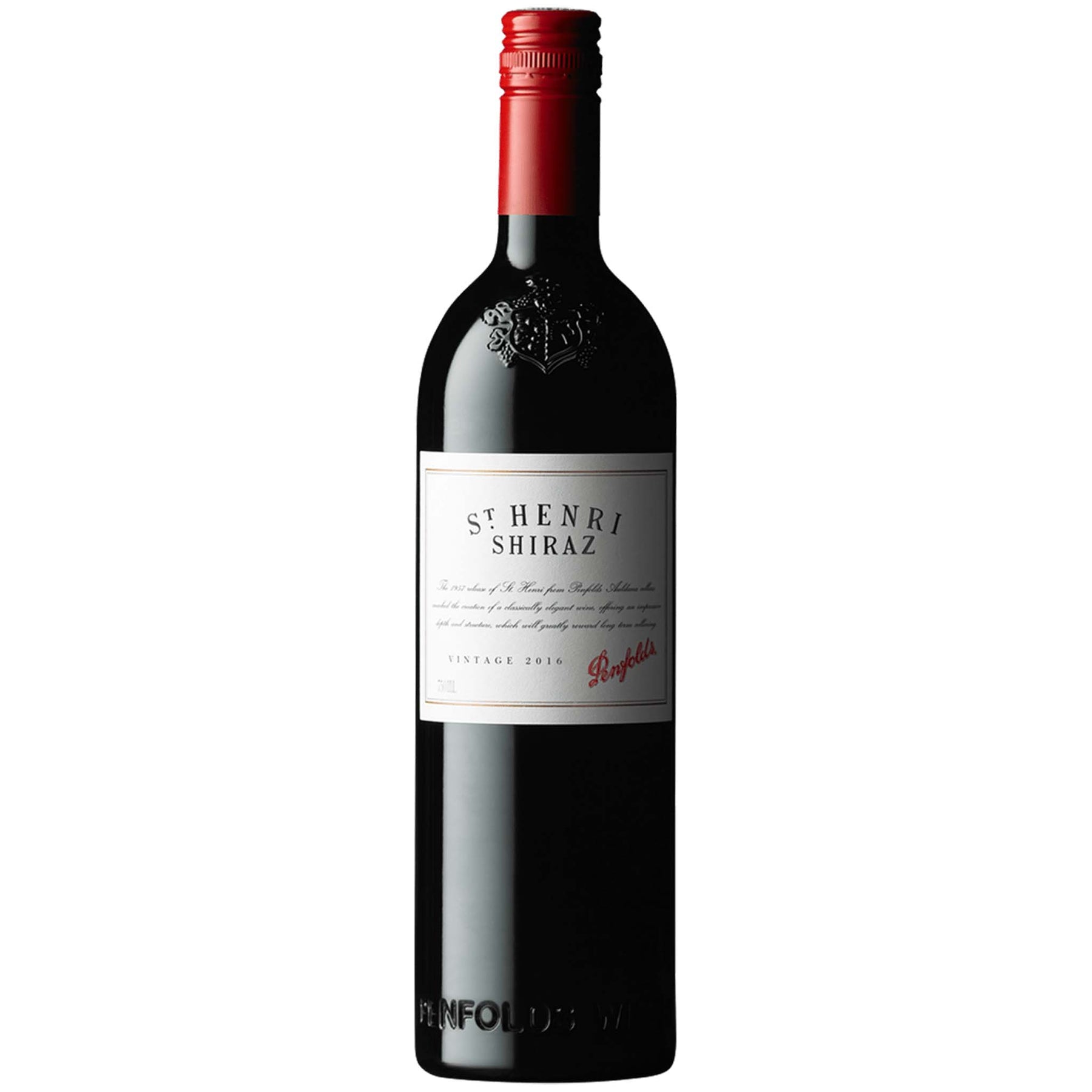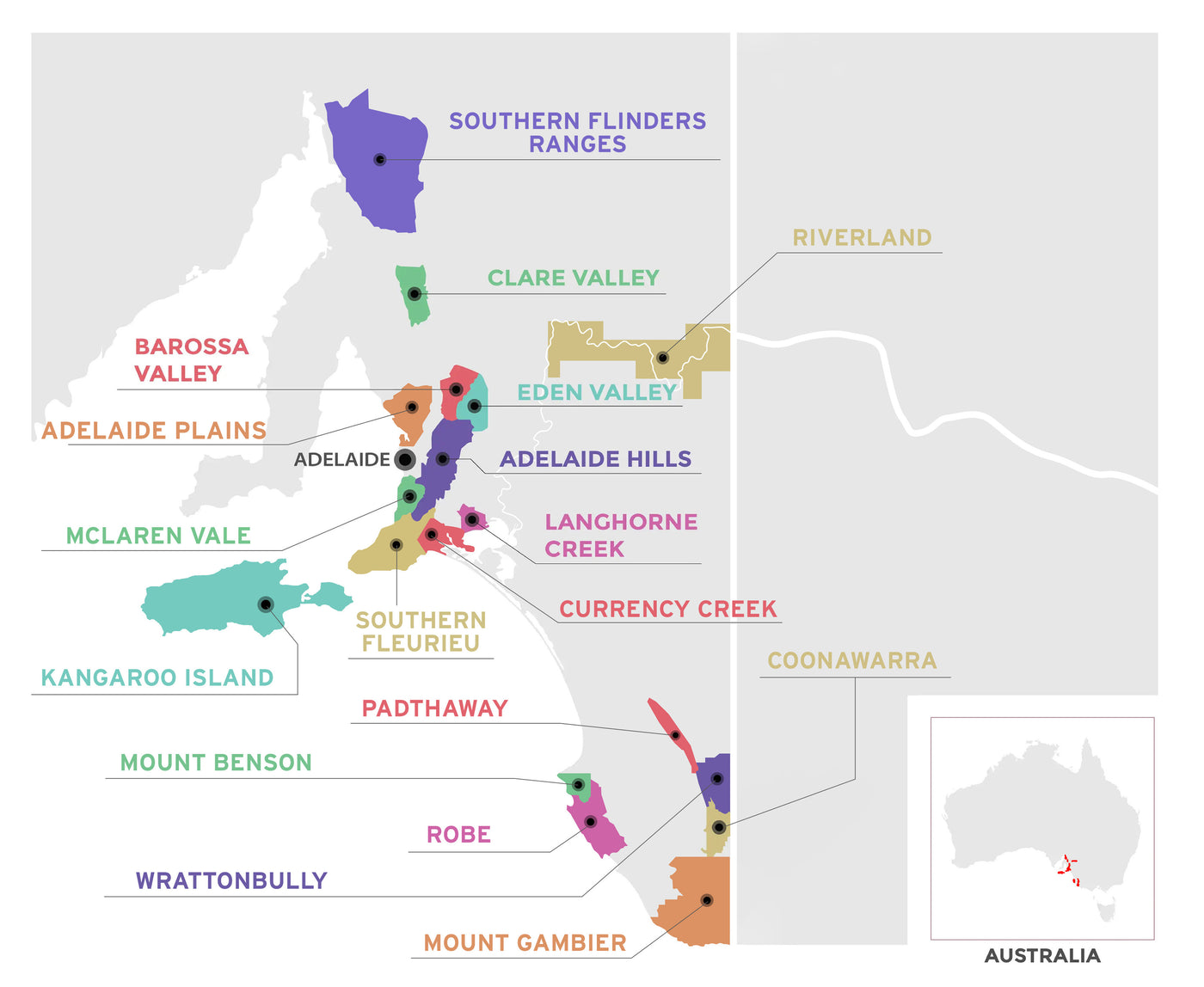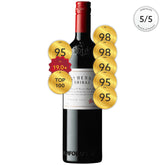

Penfolds St Henri Shiraz 2016
Style: Red Wine
Varieties: Shiraz (95%), Cabernet Sauvignon (5%)
Closure: Cork and Screwcap
Penfolds St Henri Shiraz 2016
Warehouse
34 Redland Drive
Vermont VIC 3133
Australia
Critic Score: 98
Alcohol: 14.5%
Size: 750 ml
Drink by: 2050
Penfolds Rewards of Patience tasting panel 2021 - 5/5 rating
James Suckling Top 100 Wines of Australia 2019
St Henri is a time-honoured and alternative expression of Shiraz, and an intriguing counterpoint to Grange. It is unusual among high quality Australian red wines as it does not rely on any new oak. Released for the first time by Penfolds in the early 1950s (first commercial vintage 1957), it gained a new lease of life in the 1990s as its quality and distinctive style became better understood. Proudly, a wine style that hasn't succumbed to the dictates of fashion or commerce. St Henri is rich and plush when young, gaining soft, earthy, mocha-like characters as it ages. It is matured in old, 1,460 litre vats that allow the wine to develop, imparting minimal, if any oak character. Although a small proportion of Cabernet is sometimes used to improve structure, the focal point for St Henri remains Shiraz.
"The 2016 St Henri is so profound and well-built that it took my breath away. Very complete and smooth, this is a powerful and focussed St Henri and it is certainly the finest release since the stellar 2010 vintage. With a little more upholstery and depth than I would have expected, this is a stunning wine with layers and layers of plush fruit coupled with a seriously long finish. It is nothing short of brilliant." Matthew Jukes
"The abiding character of St Henri is its longevity, particularly in the context of better vintages. It has none of the make-up of new American oak that can hide the imperfections of a lesser vintage. A great St Henri will come into its own in a bare minimum of 10 years, and live long thereafter." James Halliday
The 2016 Penfolds St Henri is a blend of 95% shiraz and 5% cabernet sauvignon from premium vineyards in the Barossa Valley, Adelaide Hills, McLaren Vale, Clare Valley, Coonawarra and Magill Estate. It was aged for 12 months in 50+ y.o. large oak vats.
"Deep crimson. Intense elderberry, blackberry, liquorice and aniseed aromas with dark chocolate notes. Massively concentrated dark plum, elderberry and blackberry fruits with dark chocolate notes and fine dense chalky-firm tannins. Finishes chocolaty with cherry liqueur notes. A powerful wine built for the long haul. A superb St Henri vintage. Peak drinking 2026 to 2060.
Vintage Conditions: Autumn and winter were dry and cool across South Australia. Below long-term average rainfall continued throughout spring and all through summer. The climactic conditions slightly delayed the start of the growing season in the Barossa Valley and other warmer regions. However, budburst, flowering, veraison and harvest were all earlier than is usually expected of Coonawarra. Warm conditions prevailed in the early part of the summer allowing vines to develop healthy canopies and good bunch set. Some late rain in January and early February was a welcome relief. Temperatures in spring and summer were above the long-term average, resulting in an early harvest for shiraz. More than 80% of McLaren Vale had been harvested by mid-March. Cool February conditions in the Adelaide Hills ensured ripening was steady and the slightly early start to vintage was a result of a mild and dry growing season. Grapes across all the main growing regions were able to ripen evenly and develop desirable flavours." Penfolds
Expert reviews
"Deep crimson. Intense elderberry, blackberry, liquorice and aniseed aromas with dark chocolate notes. Massively concentrated dark plum, elderberry and blackberry fruits with dark chocolate notes and fine dense chalky-firm tannins. Finishes chocolaty with cherry liqueur notes. A powerful wine built for the long haul. A superb St Henri vintage. Peak drinking 2026 to 2060." Penfolds Rewards of Patience tasting panel 2021 - 5/5 rating
"The 2016 St Henri is so profound and well-built that it took my breath away. Very complete and smooth, this is a powerful and focussed St Henri and it is certainly the finest release since the stellar 2010 vintage. With a little more upholstery and depth than I would have expected, this is a stunning wine with layers and layers of plush fruit coupled with a seriously long finish. It is nothing short of brilliant. Drink: 2024-2050." Matthew Jukes - 19.0+ points
"This is a much anticipated vintage for St. Henri, and it does not disappoint. The complexity of fruit here is stunning, together with a very complex and playfully fragrant, spicy edge with graphite, roasted coffee and woody spices, framing a core of very fresh blackberries, red and dark cherries and blueberries. So fresh and brimming with fruit aromas. The palate has a stunning array of deeply fleshy fruit flavors with a superb sense of length and powerful, ripe tannin, underpinning vibrant, fleshy fruit that is beautifully assembled in a refined, elegant and impressively pure mode. So long and pure. Silky and elegant. A real masterpiece, taking its place among the finest vintages like 2010, 1990 and 1971. Drink over the next three decades." James Suckling, JamesSuckling.com – 98 points and Top 100 Wines of Australia 2019
"Medium deep colour. Lovely fragrant claret style wine with exuberant fresh red cherry redcurrant, mulberry cassis aromas and roasted walnut complexity. Well concentrated and generous with inky cassis mulberry fruits, smooth velvety tannins, attractive viscosity and richness on the mid-palate and fine integrated acidity. Finishes powdery firm with superb mineral length. A hugely evocative wine; true to the original blueprint, spirit of style and the classic Penfolds multi-regional template. Delicious to drink now but should age beautifully. Drink to: 2040." Andrew Caillard MW – 98 points
"The 2016 St Henri Shiraz is one of the finest St Henris I've ever tasted, rivaling the likes of the 1986 or 1976. It's concentrated and rich, the essence of South Australia Shiraz (although it's been lightened by the addition of 5% Cabernet Sauvignon), unleavened by any new oak. Dark and tarry, it delivers notes of espresso and black olive, plummy fruit and roasted meat. Full-bodied and dense on the palate, it ends long, dark and savory." Joe Czerwinski, Robert Parker's Wine Advocate – 96 points
"Very deep, brooding red/purple colour, with a bouquet of ironstone, earth, smoke and bloody, sanguine overtones. It's youthful, bold and bright; fruit drives the wine, and it's almost lean it's so elegant; very long and refined on the follow-through, with very soft, fine-grained tannins throughout the palate. The tannins have an oaky taste but it's said not to see any small oak. This is all about finesse. Lovely wine. Drink: 2021–2040." Huon Hooke, The Real Review - 95 points
"Immediately we see blueberries, we see violets, we see plums, we see a long, elegant finish. There's no ra-ra here, it's all composure and calm. You can see this singing for a good long time. The tannin here feels teased; almost sinewy; it will hold the wine in good stead. It was/is an anticipated release and it hasn't missed the boat. Drink: 2024-2034+." Campbell Mattinson, The Wine Front - 95 points
"If Grange is a Penfolds icon, St Henri is its loyal sidekick, always without the cloak of new oak - an echo of the so-called 'Hidden Granges' when Max Schubert was denied new oak by the Penfolds board. Deep, dark and brooding in colour, its pure, liquorice-spiced Shiraz fragrance shines through on the nose. As mentioned, this is unadorned by new oak, but its chocolatey richness and power - buttressed by 5% Cabernet Sauvignon - is in no way diminished without it. It displays concentrated opulent, spice-laden dark cherry and cassis primary fruit, texturally seamless and savoury with a fine spine of acidity and firm, chewy tannins. Excellent long-term ageing potential. Drink with lamb steaks." Anthony Rose, Decanter - 95 points
Awards
Penfolds Rewards of Patience tasting panel 2021 - 5/5 rating
Top 100 Wines of Australia 2019 - James Suckling
About st henri

The first vintage of St Henri – then Auldana Cellars St Henri Claret – was produced in 1888, beginning one of the most famous and enduring names in Australian wine. It was likely named after Auldana's winemaker Léon Edmond Mazure's son Henri or his wife, Philomine Henriette. The wine immediately enjoyed success, winning the Championship Cup for Best Claret in Australia at the Adelaide Wine Show in 1890 and then again as a joint winner in 1891. The St Henri label disappeared somewhere around the beginning of World War 1, probably because of reduced export sales. It was revived by Senior Red Winemaker John Davoren at Penfolds in 1953 to celebrate the centenary of Auldana Cellars (established by Patrick Auld in 1853) but the wine was not widely released. The 1953 release was made from Auldana and Paracombe fruit and the label design was based on original St Henri labels found in a loft at Auldana Cellars shortly after its sale to Penfolds in 1947.
According to retired Penfolds Senior Winemaker John Bird, the first vintages of St Henri were cabernet sauvignon and mataro blends. The fruit was foot stomped in open-ended hogsheads during vinification. After fermentation, the wine was matured in oak vats rather than hogsheads for around 18 months. John Davoren's aim was to make a wine in the traditional Claret style, accentuating fruit and maturation characters, rather than oak complexity. In this way the winemaking style differs to Grange, as it relies on larger seasoned oak vessels without any barrel fermentation. The 1957 vintage is officially recognised as the first St Henri commercial release under the Penfolds name. Nonetheless, John Davoren describes all of the 1950s vintages as "trials”. These experimental wines from 1953 to 1959 mark an important step forward for winemaking in Australia. Not only does St Henri honour the late 19th-century aspirations of Auldana's proprietor Sir Josiah Symon and winemaker Léon Edmond Mazure, but without the professional rivalry between Max Schubert and John Davoren, the Grange story would not have the same richness or romance. Initially St Henri achieved greater commercial success than Grange, although both were offered to the public as Claret styles. St Henri was a more elegant, approachable and familiar style because it reflected traditional winemaking techniques, whereas the revolutionary Grange was something of a blockbuster with more richness and fullness.
Today Penfolds St Henri is a multi-regional multi-vineyard South Australian blend, primarily based on shiraz, although it still honours the original style. Significant contrbutions of shiraz come from Barossa Valley, Eden Valley, Clare Valley, McLaren Vale, Langhorne Creek, Robe and Bordertown; cabernet sauvignon from Coonawarra, Barossa Valley and Adelaide Hills. After vinification the wine is matured in seasoned large oak vats for around 15 to 18 months before bottling.
St Henri was labelled 'Claret' until the 1989 vintage. Packaged in laser-etched bottles
since the 1996 vintage. Released in many markets under screwcap since 2005. St Henri Shiraz possesses a unique stature in the story of Australian wine. With its proven style and aging potential, it is a favourite among Penfold's collectors.
Extract from Penfolds Rewards of Patience tasting panel 2021
After the success of early sherries and fortified wines, founders Dr Christopher and Mary Penfold planted the vine cuttings they had carried on their voyage over to Australia. In 1844 the fledging vineyard was officially established as the Penfolds wine company at Magill Estate.
As the company grew, so too did Dr Penfold's medical reputation, leaving much of the running of the winery to Mary Penfold. Early forays into Clarets and Rieslings proved increasingly popular, and on Christopher's death in 1870, Mary assumed total responsibility for the winery. Mary's reign at the helm of Penfolds saw years of determination and endeavour.
By the time Mary Penfold retired in 1884 (ceding management to her daughter, Georgina) Penfolds was producing 1/3 of all South Australia's wine. She'd set an agenda that continues today, experimenting with new methods in wine production. By Mary's death in 1896, the Penfolds legacy was well on its way to fruition. By 1907, Penfolds had become South Australia's largest winery.
In 1948, history was made again as Max Schubert became the company's first Chief Winemaker. A loyal company man and true innovator, Schubert would propel Penfolds onto the global stage with his experimentation of long-lasting wines - the creation of Penfolds Grange in the 1950s.
In 1959 (while Schubert was perfecting his Grange experiment in secret), the tradition of ‘bin wines' began. The first, a Shiraz wine with the grapes of the company's own Barossa Valley vineyards was simply named after the storage area of the cellars where it is aged. And so Kalimna Bin 28 becomes the first official Penfolds Bin number wine.
In 1960, the Penfolds board instructed Max Schubert to officially re-start production on Grange. His determination and the quality of the aged wine had won them over.
Soon, the medals began flowing and Grange quickly became one of the most revered wines around the world. In 1988 Schubert was named Decanter Magazine's Man of the Year, and on the 50th anniversary of its birth, Penfolds Grange was given a heritage listing in South Australia.
Despite great success, Penfolds never rests on its laurels. In 2012 Penfolds released its most innovative project to date - 12 handcrafted ampoules of the rare 2004 Kalimna Block Cabernet Sauvignon.
Two years later, Penfolds celebrated the 170th anniversary – having just picked up a perfect score of 100 for the 2008 Grange in two of the world's most influential wine magazines. Today, Penfolds continues to hold dear the philosophies and legends – ‘1844 to evermore!'.

South Australia
South Australian is responsible for more than half the production of all Australian wine. It is home to more than 900 wineries across 18 wine regions. The regions are Adelaide Hills, Adelaide Plains, Barossa Valley, Clare Valley, Coonawarra, Currency Creek, Eden Valley, Kangaroo Island, Langhorne Creek, McLaren Vale, Mount Benson, Mount Gambier, Padthaway, Riverland, Robe, Southern Fleurieu, Southern Flinders Ranges and Wrattonbully.
Many of the well-known names in the South Australian wine industry established their first vineyards in the late 1830s and early 1840s. The first vines in McLaren Vale were planted at Reynella in 1839 and Penfold's established Magill Estate on the outskirts of Adelaide in 1844.
South Australia has a vast diversity in geography and climate which allows the State to be able to produce a range of grape varieties - from cool climate Riesling in the Clare and Eden Vallies to the big, full bodied Shiraz wines of the Barossa Valley and McLaren Vale. Two of Australia's best-known wines, Penfolds Grange and Henschke Hill of Grace, are produced here. There is much to discover in South Australia for the wine lover.



